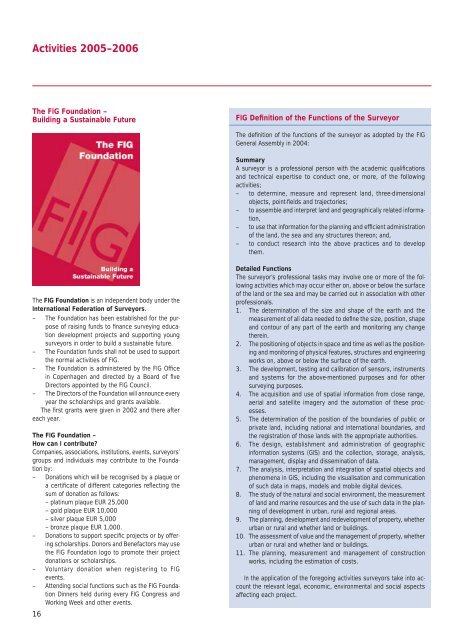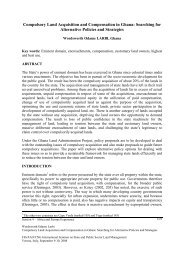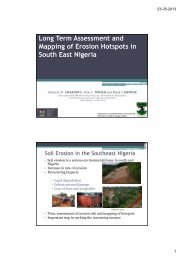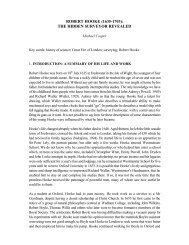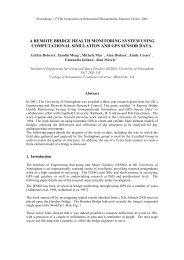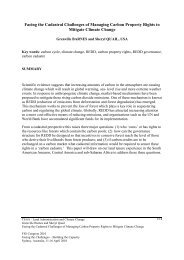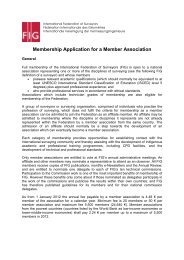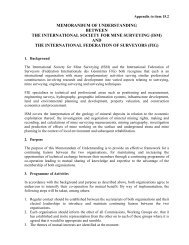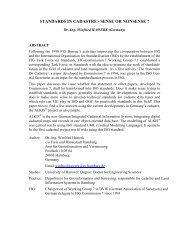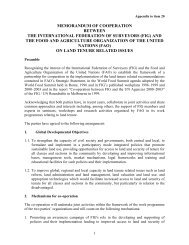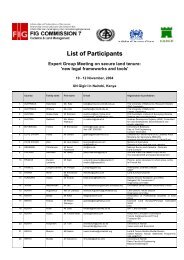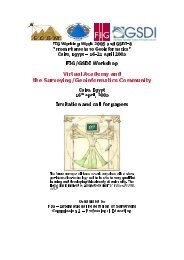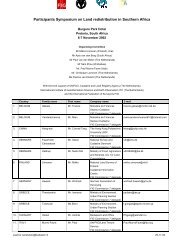XXIII International FIG Congress German
XXIII International FIG Congress German
XXIII International FIG Congress German
You also want an ePaper? Increase the reach of your titles
YUMPU automatically turns print PDFs into web optimized ePapers that Google loves.
Activities 2005–2006<br />
The <strong>FIG</strong> Foundation –<br />
Building a Sustainable Future<br />
The <strong>FIG</strong> Foundation is an independent body under the<br />
<strong>International</strong> Federation of Surveyors.<br />
– The Foundation has been established for the purpose<br />
of raising funds to fi nance surveying education<br />
development projects and supporting young<br />
surveyors in order to build a sustainable future.<br />
– The Foundation funds shall not be used to support<br />
the normal activities of <strong>FIG</strong>.<br />
– The Foundation is administered by the <strong>FIG</strong> Offi ce<br />
in Copenhagen and directed by a Board of fi ve<br />
Directors appointed by the <strong>FIG</strong> Council.<br />
– The Directors of the Foundation will announce every<br />
year the scholarships and grants available.<br />
The fi rst grants were given in 2002 and there after<br />
each year.<br />
The <strong>FIG</strong> Foundation –<br />
How can I contribute?<br />
Companies, associations, institutions, events, surveyors’<br />
groups and individuals may contribute to the Foundation<br />
by:<br />
– Donations which will be recognised by a plaque or<br />
a certifi cate of different categories refl ecting the<br />
sum of donation as follows:<br />
– platinum plaque EUR 25,000<br />
– gold plaque EUR 10,000<br />
– silver plaque EUR 5,000<br />
– bronze plaque EUR 1,000.<br />
– Donations to support specifi c projects or by offering<br />
scholarships. Donors and Benefactors may use<br />
the <strong>FIG</strong> Foundation logo to promote their project<br />
donations or scholarships.<br />
– Voluntary donation when registering to <strong>FIG</strong><br />
events.<br />
– Attending social functions such as the <strong>FIG</strong> Foundation<br />
Dinners held during every <strong>FIG</strong> <strong>Congress</strong> and<br />
Working Week and other events.<br />
16<br />
<strong>FIG</strong> Defi nition of the Functions of the Surveyor<br />
The defi nition of the functions of the surveyor as adopted by the <strong>FIG</strong><br />
General Assembly in 2004:<br />
Summary<br />
A surveyor is a professional person with the academic qualifi cations<br />
and technical expertise to conduct one, or more, of the following<br />
activities;<br />
– to determine, measure and represent land, three-dimensional<br />
objects, point-fi elds and trajectories;<br />
– to assemble and interpret land and geographically related information,<br />
– to use that information for the planning and effi cient administration<br />
of the land, the sea and any structures thereon; and,<br />
– to conduct research into the above practices and to develop<br />
them.<br />
Detailed Functions<br />
The surveyor’s professional tasks may involve one or more of the following<br />
activities which may occur either on, above or below the surface<br />
of the land or the sea and may be carried out in association with other<br />
professionals.<br />
1. The determination of the size and shape of the earth and the<br />
measurement of all data needed to defi ne the size, position, shape<br />
and contour of any part of the earth and monitoring any change<br />
therein.<br />
2. The positioning of objects in space and time as well as the positioning<br />
and monitoring of physical features, structures and engineering<br />
works on, above or below the surface of the earth.<br />
3. The development, testing and calibration of sensors, instruments<br />
and systems for the above-mentioned purposes and for other<br />
surveying purposes.<br />
4. The acquisition and use of spatial information from close range,<br />
aerial and satellite imagery and the automation of these processes.<br />
5. The determination of the position of the boundaries of public or<br />
private land, including national and international boundaries, and<br />
the registration of those lands with the appropriate authorities.<br />
6. The design, establishment and administration of geographic<br />
information systems (GIS) and the collection, storage, analysis,<br />
management, display and dissemination of data.<br />
7. The analysis, interpretation and integration of spatial objects and<br />
phenomena in GIS, including the visualisation and communication<br />
of such data in maps, models and mobile digital devices.<br />
8. The study of the natural and social environment, the measurement<br />
of land and marine resources and the use of such data in the planning<br />
of development in urban, rural and regional areas.<br />
9. The planning, development and redevelopment of property, whether<br />
urban or rural and whether land or buildings.<br />
10. The assessment of value and the management of property, whether<br />
urban or rural and whether land or buildings.<br />
11. The planning, measurement and management of construction<br />
works, including the estimation of costs.<br />
In the application of the foregoing activities surveyors take into account<br />
the relevant legal, economic, environmental and social aspects<br />
affecting each project.


